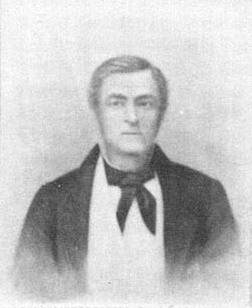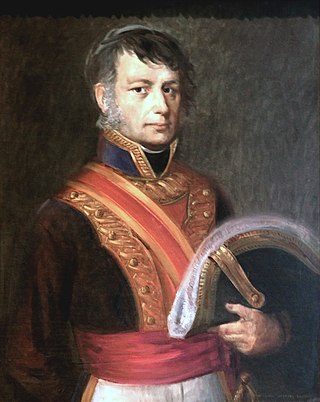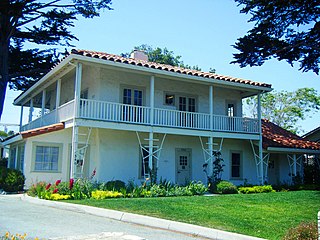
William Edward Petty Hartnell, later known by his Spanish name Don Guillermo Arnel, was a merchant, schoolmaster, and government official in California. He arrived in California in 1822 as a trader, where he married into the prominent Guerra family of California and became a Mexican citizen. He held several public roles during the Mexican era and after the American Conquest of California, notably serving as the official translator at the Monterey Constitutional Convention.

Monterey State Historic Park is a historic state park in Monterey, California. It includes part or all of the Monterey Old Town Historic District, a historic district that includes 17 contributing buildings and was declared a National Historic Landmark in 1970. The grounds include California's first theatre, and the Monterey Custom House, where the American flag was first raised over California.

The Portolá expedition was a Spanish voyage of exploration in 1769–1770 that was the first recorded European exploration of the interior of the present-day California. It was led by Gaspar de Portolá, governor of Las Californias, the Spanish colonial province that included California, Baja California, and other parts of present-day Mexico and the United States. The expedition led to the founding of Alta California and contributed to the solidification of Spanish territorial claims in the disputed and unexplored regions along the Pacific coast of North America.

José Antonio Estudillo was a Californio ranchero, politician, and soldier, who served as Alcalde of San Diego and as San Diego County Assessor. He was a member of the Estudillo family of California, a prominent Californio family of San Diego.

Don Miguel de Pedrorena was a Spanish-born Californio ranchero, merchant, and a signer of the California Constitution in 1849. He also served briefly as acting Alcalde of San Diego (mayor).

José Antonio Castro was a Californio politician, statesman, and general who served as interim Governor of Alta California and later Governor of Baja California. During the Bear Flag Revolt and the American Conquest of California, Castro led Mexican forces as the Commandante General of Northern California.

José Antonio Aguirre (1799–1860), commonly known as Don Antonio Aguirre, was a Spanish-born Californio merchant and ranchero, active in the Southern Californian cities of San Diego and Santa Barbara.

The José Castro House, sometimes known as the Castro-Breen Adobe, is a historic adobe home in San Juan Bautista, California, facing the Plaza de San Juan. The Monterey Colonial style house was built 1838-41 by General José Antonio Castro, a former Governor of Alta California. It was later sold to the Breen family, who lived there until 1933, when the house became a museum as part of San Juan Bautista State Historic Park.

The Estudillo family is a prominent Californio family of Southern California. Members of the family held extensive ranchos and numerous important positions, including California State Treasurer, mayor of San Diego, and commandant of the Presidio of San Diego.

The Mexican Secularization Act of 1833, officially called the Decree for the Secularization of the Missions of California, was an act passed by the Congress of the Union of the First Mexican Republic which secularized the Californian missions. The act nationalized the missions, transferring their ownership from the Franciscan Order of the Catholic Church to the Mexican authorities.

The Covarrubias adobe is a California Historical Landmark in Santa Barbara, California. The house is one of the oldest in Santa Barbara, built in 1817. The adobe became a California State Historical Landmark No. 308 on September 12, 1939. The house is also on the Santa Barbara City Landmark. The house is located at 715 Santa Barbara Street. The house is L-shaped with four rooms. The original Spanish tile roof was later replaced.

Camp Salvation was a refugee camp set up on September 23, 1849, to help those traveling to the California Gold Rush. Emigrants were crossing the harsh Sonoran Desert to get to California through the Southern Emigrant Trail. The camp was located in the current town of Calexico, California. Lieutenant Cave Johnson Couts, an Escort Commander with the International Boundary Commission set up the camp. From September 23 till December 1, 1849, the camp helped travelers on the trail. In June 1849 the United States Boundary Commission arrived in San Diego to survey the international border between United States and Mexico.

The Carrillo family is a prominent Californio family of Southern California. Members of the family held extensive rancho grants and numerous important political positions, including Governor of Alta California, Mayor of Los Angeles, Mayor of Santa Barbara, Mayor of Santa Monica, and a signer of the Californian Constitution.

José Abrego was a 19th-century Californian merchant. He arrived in Alta California in 1834 as a member of Compania Cosmopolitan A, part of the Hijar-Padrés colony. It was led by José Maria Hijar and Don José Maria Padrés. Abrego became a merchant in Monterey, California, and held a variety of political offices. He served as treasurer of the territory from 1839 to 1846. After the Mexican–American War, he continued to operate as a merchant. He became very wealthy and built a home that is still preserved in Monterey.

The Vásquez House, also known as Vásquez Adobe, is a historic two-story adobe building located at 546 Dutra Street in Monterey, California. It was occupied by Dolores a sister of Tiburcio Vásquez (1835–1875), who was a Californio bandido that was active in California from 1854 to 1874. The building is listed as a California Historical Landmark #351. It is owned by the City of Monterey, which uses it as the administrative office of its Park and Recreation Department.

Casa de López was a historical adobe building in San Diego, California, constructed in the early 1800s. The Casa de López site is a California Historical Landmark No. 60, listed on December 6, 1932. Often called la casa larga, or long house, it was built for the López family, early Spanish settlers of San Diego.

Fort Stockton, later called Fort Dupont, was a historical fortress in San Diego, California, built in 1828. The Fort Stockton site is a California Historical Landmark No. 54, listed on December 6, 1932.

San Diego Viejo Plaza, also called Plaza de Las Armas, Old Town Plaza, and Washington Square, is a historical site in San Diego, California. The San Diego Viejo Plaza site is California Historical Landmark No. 63, listed on December 5, 1932. The plaza was the center of the Pueblo de San Diego, founded in 1835 in Alta California.

José Matías Moreno II (1819–1869) was secretary of state under Pío Pico, the last Mexican governor of California; a Mexican patriot; and a major landowner in the Guadalupe Valley, Baja California, Mexico.





















